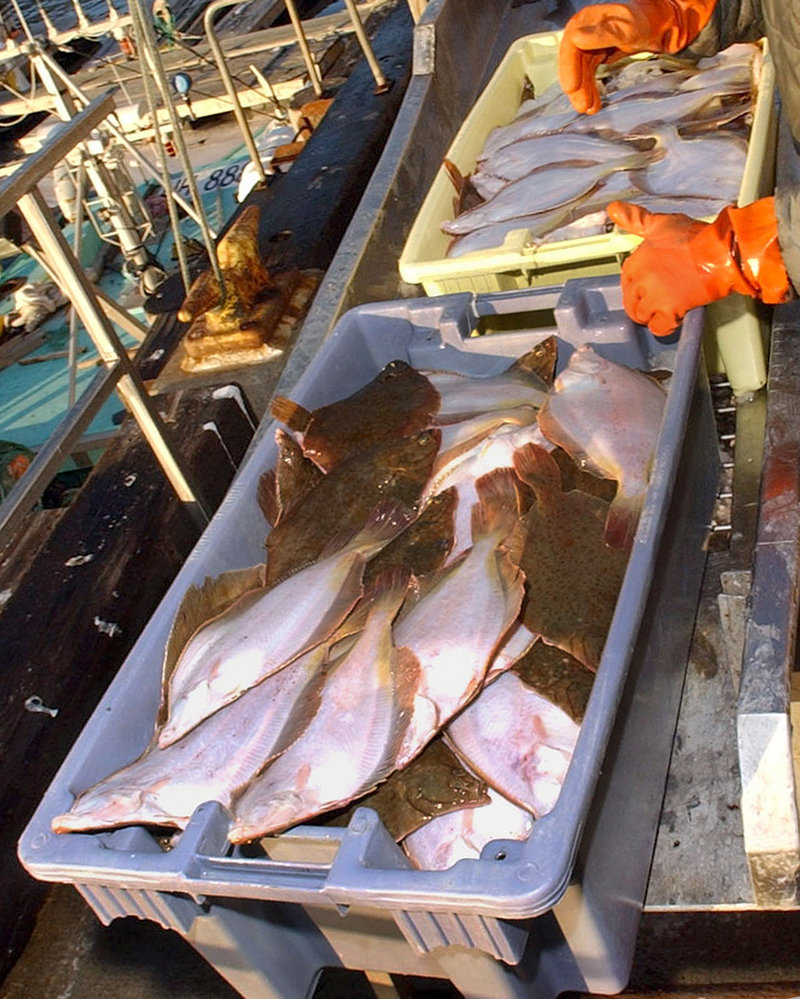Fishermen who are fighting to stay in business because their yellowtail flounder catch was slashed 80 percent have gotten a hand, and tons more fish, from the Northeast’s scallop fleet.
The New England Fishery Management Council voted Thursday in Portland to shift nearly half of the scallopers’ allotment of yellowtail to fishermen who catch cod and other bottom-dwelling groundfish. That amounts to a nearly 70 percent increase in the fishermen’s yellowtail catch this year.
In return, the scallopers won’t be penalized if they exceed their new, lower catch limit for yellowtail.
While the transfer offers some relief, it’s not enough to offset the steep initial cut, enacted May 1. And preliminary data discussed at the council meeting indicates the yellowtail catch might get another drastic cut in 2013.
Still, fishing advocates welcomed the extra fish.
“We must have a today, in order to have a tomorrow. We’ve got to do something,” said Vito Calomo, a former commercial fisherman who now works for U.S. Sen. Scott Brown, R-Mass.
The yellowtail aren’t a high-value fish, pulling in $4.1 million in 2010 in New England, compared with $22 million for haddock, for instance. But fishermen can’t exceed their yellowtail catch limits, or they must stop fishing for all species.
The low catch limit also prevents them from chasing the more valuable fish that the yellowtail swim among, for fear of pulling up too much yellowtail.
Each year, fishery managers set a yellowtail catch limit for scallopers, who catch the fish inadvertently. This year, scallopers received an allotment of about 307 metric tons. Fishermen, meanwhile, received just 218 metric tons, down from about 1,120 in 2011.
The cut is so restricting that fishermen have repeatedly warned it could make the industry collapse.
Relief via the scallop fleet has been discussed for weeks. The lucrative scallop fleet, which pulled in $265 million in 2010, has grown increasingly skilled at avoiding yellowtail and was confident it wouldn’t catch its full allotment.
On Thursday, the council shifted 150 metric tons of yellowtail catch from the scallopers to fishermen, bumping up the fishermen’s total to 368 metric tons while leaving the scallopers with about 157.
Some environmental groups objected to a provision that exempts the scallopers from penalties — such as being shut out of certain fishing areas — if they exceed their new catch limit.
“It seems that we’re creating fish out of thin air here, and it’s not supportable and it’s not accountable,” said Gib Brogan of Oceana.
But scallop industry advocates said their yellowtail catch would still be closely tracked.
The yellowtail troubles are just the most recent problem for New England’s fishing industry, which also faces a massive cut in the Gulf of Maine cod catch in 2013. And there were indications Thursday that the yellowtail problem could soon get far worse.
An early report indicates that yellowtail is continuing to suffer from historically poor reproduction, even as the fish shrink in size. That could mean further restrictions to protect it, with the catch limit possibly dropping to a scant 200 metric tons for the scallopers and fishermen combined. It’s a preliminary number that, if ever enacted, would cause huge problems for both fleets.
Richie Canastra of BASE New England, which runs fish auctions, said the poor projections are a product of poor science that’s overstating the problems with yellowtail.
But Ron Smolowicz, a researcher with the Fisheries Survival Fund, a scallopers group, said there’s clearly something wrong with yellowtail.
“If we don’t start really attacking this situation, things are going to be hell over the next couple of years,” he said.
Copy the Story Link
Send questions/comments to the editors.



Success. Please wait for the page to reload. If the page does not reload within 5 seconds, please refresh the page.
Enter your email and password to access comments.
Hi, to comment on stories you must . This profile is in addition to your subscription and website login.
Already have a commenting profile? .
Invalid username/password.
Please check your email to confirm and complete your registration.
Only subscribers are eligible to post comments. Please subscribe or login first for digital access. Here’s why.
Use the form below to reset your password. When you've submitted your account email, we will send an email with a reset code.